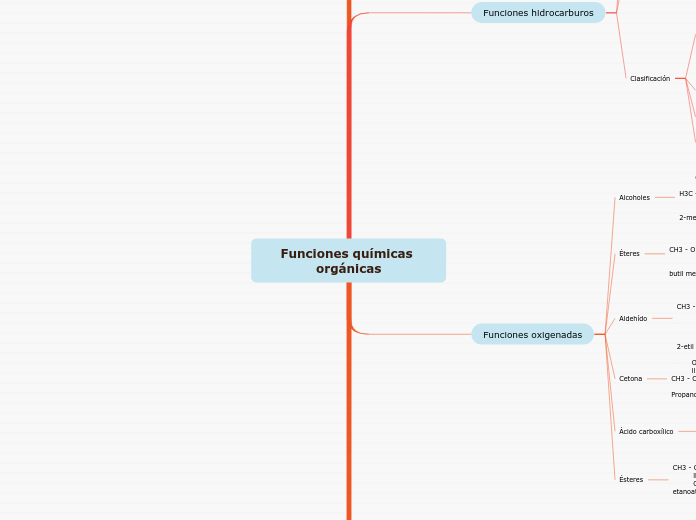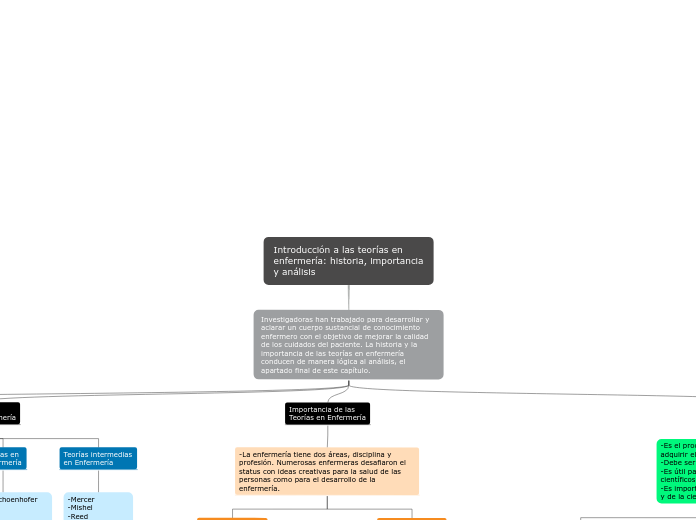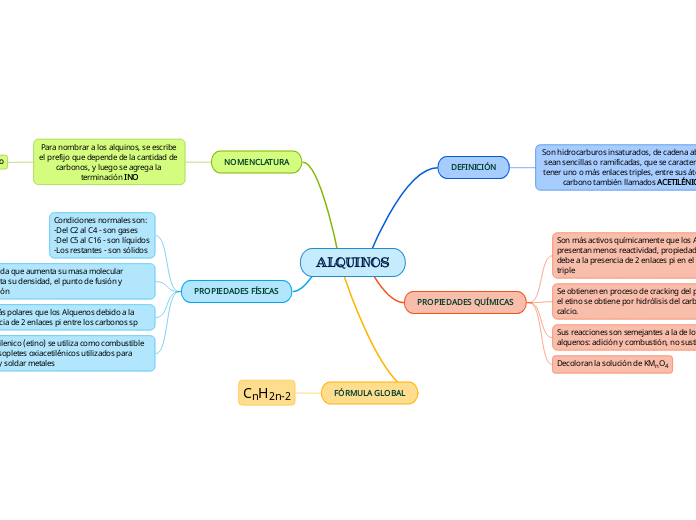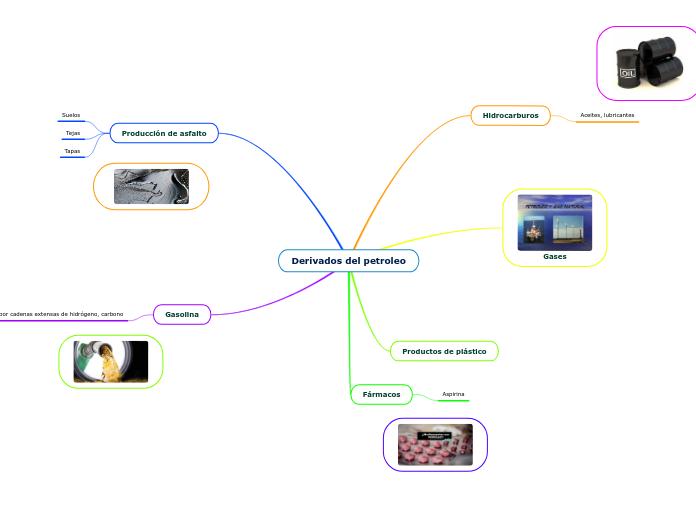Funciones químicas orgánicas
To name your story, you have to think about the overall message and what you want your audience to understand from the story. Also, make it relevant and easy to remember.
Importancia
La industria química juega un papel muy importante en la economía mundial e incide en muchos aspectos de nuestra vida diaria con sus productos
Todos los compuestos responsables de la vida son sustancias orgánicas
Más del 95% de las sustancias químicas conocidas son compuestos del carbono y más de la mitad de los químicos actuales en el mundo se denominan a sí mismos químicos orgánicos
Funciones nitrogenadas
Hidrazina
H2N - NH2
Isonitrilo
R - C ≡ N
Nitrilo
H - C ≡ N
Metanonitrilo
Amidas
. O
. ll
. C
. / \
CH3 NH2
Acetamida
A story is nothing more than a character overcoming a series of difficulties to reach the desired goal. Obstacles usually create suspense and conflict. In overcoming obstacles, there is growth: weak becomes strong; hatred turns into love; sadness into happiness; wrong into right; lies into truth; or evil becomes good.
See a few examples below:
- stopping a meteor
- finding a killer
- finding love
Aminas
CH3NH2
Metilamina
Secondary characters might also have motives that lead them to cross paths with the main character or which might trigger them to help the main character.
Aminoácido
. R
. l
NH2 - CH - COOH
In most stories, there are 3 challenges. The number 3 is a mystical number symbolizing completeness. Try to come up with interesting challenges with which your character needs to struggle.
See a few examples below:
- turns into a werewolf at night
- is sent back in time
Funciones oxigenadas
The middle of the story is where you add layers of complications that will lead to the end. Reveal more about the character's journey. Did their personality go through changes? How did they overcome the challenges? And as you build up the story’s central conflict, make it more personal to that character. Also, from the middle act, you have to lead into the final act.
Ésteres
CH3 - C - O - CH3
. ll
. O
etanoato de metilo (acetato)
Ácido carboxílico
. O
. //
H - C
. \
. OH
Ácido metanoico
Cetona
. O
. ll
CH3 - C - CH3
Propanona
Aldehído
There wouldn't be any tension and excitement in your story if there weren't any obstacles in your character's way.
. O
. //
CH3 - CH2 - CH - CH - C
. l l \
. CH3 CH2 H
. l
. CH3
2-etil 3-metilpentanal
Éteres
Your character(s) need(s) motivation in order to solve the challenge(s).
. CH3
l
CH3 - O - C - CH3
l
CH3
butil metil éter
Alcoholes
Each story has a main character and that character usually needs to solve a problem or challenge. The character's challenge is the one that creates tension throughout the story.
. CH3
l
H3C - C - OH
l
CH3
2-metil 2-propanol
Funciones hidrocarburos
In the beginning of the story (or the exposition), you will need to introduce the setting and characters. You might also want to introduce the main conflict. This part of the story is important because it gives the reader necessary background information and maybe even a first insight into a character’s personality.
Clasificación
The setting (time & place) of a story can change throughout the plot.
Aromáticos
Sensory details include sight, sound, touch, smell, and taste. These details are important because they create depth in your setting.
See a few examples below:
- the smell of fresh bread
- the scent of freshly cut grass
- rain falling onto the windshield etc.
Poliaromáticos
Benceno
Derivados Halogenados
The weather is an important element in your story because it can highly influence the ambiance and the mood of the characters.
Halogenuros
Does your story include catastrophic weather? See a few suggestions below or add your own:
- hurricane, earthquake, storm, etc
Alicíclicos
The time of the story can also change. It can describe the event of a single day or can include an entire year's plot. Anyway, don't forget to mention it.
Ciclo alquenos
Ciclo alcanos
Alifáticos
Your story can take place wherever your imagination will take you to.
For example: in an elevator, in an enchanted forest, etc. Don't forget to give details of the environment each time the setting changes, otherwise, the story can be confusing. Also, mention the seasons as each of them has unique weather and events.
Alquinos
CH3 - C ≡ C - CH3
2-butino
Alquenos
CH3CH = CH2
Etano
Alcanos
CH3 - CH3
Etano
Combustión
Combustibles líquidos son puestos en la fase gaseosa antes de la combustión
Produce el calor + otro compuesto
Reacción química entre un combustible y un oxidante
Origen
Characters are essential to a good story. Usually, the protagonist(s) is/are the most affected by the plot. Introduce a character by focusing on their actions, interests, and occupation, as the physical appearance doesn't make a difference in most cases.
Fuentes no renovables
Fósiles
Type in the name of your character.
Gas natural
What is your character's main goal?
fight Evilfind lovedefeat his/her enemyrule the worldmake friendstime travelmake an awesome discoveryOther
Petróleo
Which traits best describe the character's personality? Choose more if necessary:
introvertedloyalkindindependentquick-thinkingadventuresomeidealisticsweet-naturedcalmrisk-takercreativewittystrictfussyweirdclumsyharshaggressivecarelessclingingcowardlycrueldeceitfulimpulsiveOther
Carbón
Choose the type of your chacter:
Protagonist (main character)Antagonist (main character's opponent)Flat (stereotypical character)Round (his/ her personality develops throughout the story)Static (doesn't evolve as a person throughout the story)Dynamic (dramatical change in personality)Confidant (the main character trusts him/ her)Foil (contrasting character who enhances the personality of another character)Other
Concepto y origen
The ending of a story is essential. We all know that if the ending is weak, what happened before loses its importance. So make it unpredictable, but fair. A resolved ending answers all the questions and ties up any loose threads from the plot.
La química orgánica se ocupa del estudio de las propiedades y transformaciones de los compuestos que contienen el elemento carbono a excepción de los carburos, carbonatos y óxidos de carbono
This is the closure section of the story.
See examples of possible outcomes below:
- all problems have been solved
- it's clear how each one of your characters ends up
- your main character is transformed by the challenge
El nombre química orgánica proviene de la antigua creencia de que los compuestos orgánicos solo podían ser producidos por organismos vivos
This is the moment when the main character surpasses the last obstacle and finally faces their greatest challenge.
The climax usually follows one of these patterns:
- realization
- resolution
- choice
Type in your answer.










